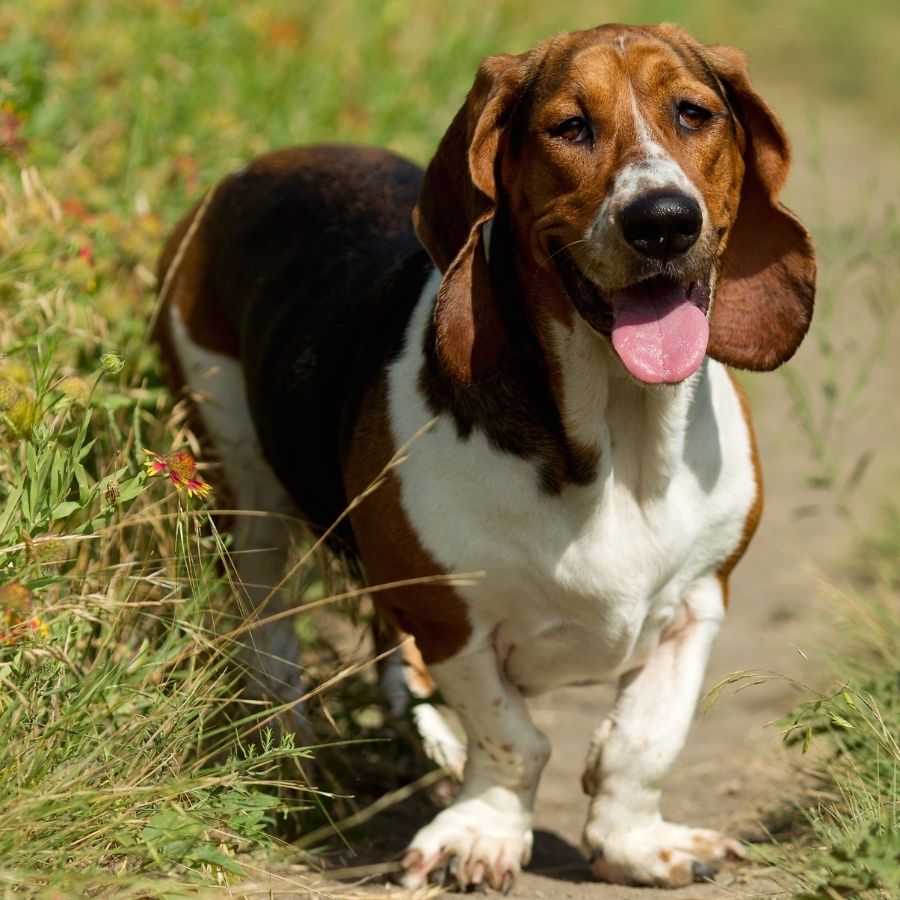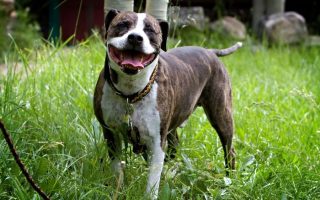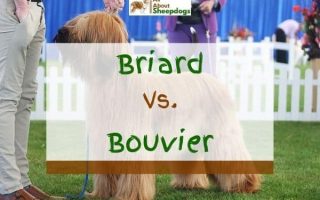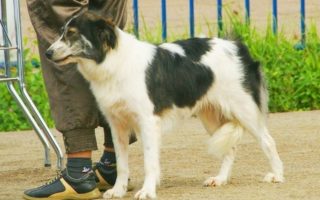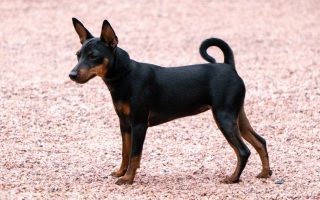Great Dane Vs Rottweiler, what a mind-blowing comparison!
If you have ever interacted with either of these 2 dog breeds, the chances are that you have asked yourself these questions;
What makes these 2 dog breeds special? Why are they so famous? And would I want to adopt one?
So, if you are stuck in between (just like thousands of dog enthusiasts) on which dog breed to adopt, then read on as I got you covered through this article.
I will walk you through these 2 dogs’ history, physical appearance, lifespan, health conditions, nutritional and exercise requirements, grooming needs, and temperaments.
I will also provide you with a complete summary of their major differences, which I am confident will help you decisively choose between the two.
| Attributes | Great Dane | Rottweiler |
| Good For First Time Owners | No | No |
| Good Guard Dog | Yes | Yes |
| Apartment Friendly | Yes | Yes |
| Good Family Dog | Yes | Yes |
| Shedding | Moderate To Heavy | Moderate |
| Barking And Howling | Moderate | Low |
| Height | 28-32 inches (71-81 cm) | 22-27 inches (56-69cm) |
| Average Life Expectancy | 9-10 Years | 8-10 Years |
[wpsm_toplist]
Great Dane – Dog Breed Information
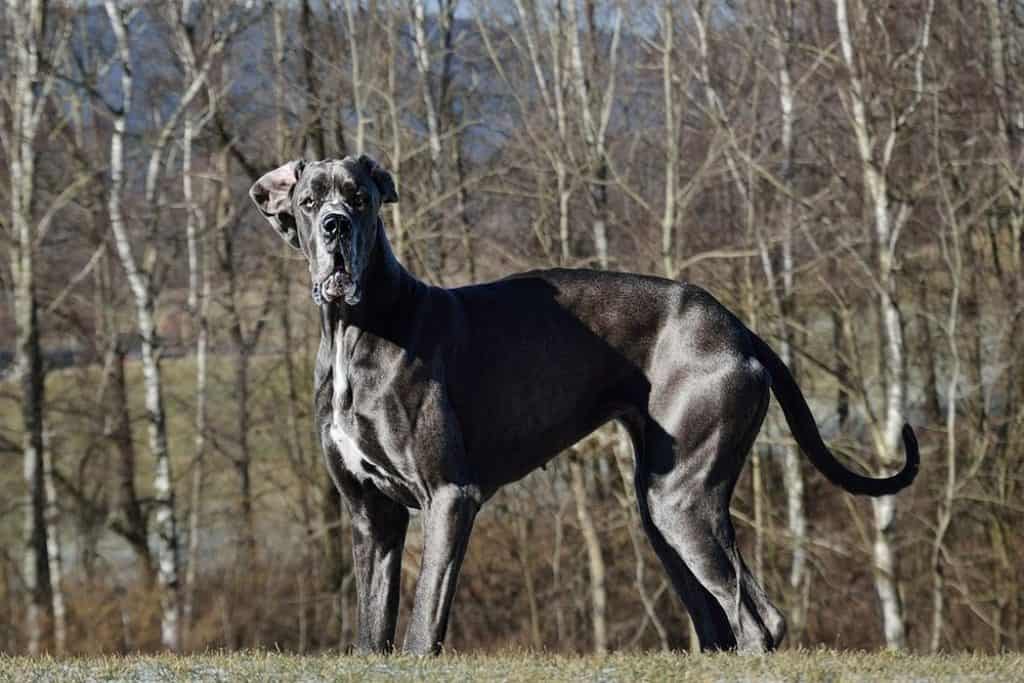
Also known as Apollo of dogs, Dane, Deutsche Dogge, Gentle Giant, and German Mastiff.
History And Physical Appearance
Great Danes are believed to be descendants of mastiff dogs.
These large-sized dog breed origins can be traced back to Germany around the early 17th century, where it was bred as a hunting dog among the nobles.
The America Kennel Club recognized it as a working dog breed in 1887.
Great Danes are the tallest dogs in the world as they can grow to heights of 28-32 inches long.
These dogs also weigh around 45-90 kgs when fed a proper and balanced diet. Males are always large in size than females.
Its massive rectangular head, almond-shaped eyes, medium-sized floppy ears, and masculine body gives this dog breed its characteristic features.
These hounds have a smooth and short single coat that comes in satisfying shades of black, brindle, fawn, harlequin, merle, and white.
Lifespan And Health Conditions
This dog breed has a life expectancy of 7-10 years.
Despite being a relatively healthy dog breed, it’s also predisposed to a number of medical conditions such as;
Cancer, Heart conditions (Dilated Cardiomyopathy, mitral valve disease, patent ductus arteriosus, subvalvular aortic stenosis), and hip dysplasia.
Nutritional And Exercising Requirements
Great Danes need foods rich in premium proteins and moderate fats (17-23% calories).
Consider feeding your Dane 3 times in a day.
An adequately hydrated Dane will perform its tasks at an optimal level, so don’t forget to keep it hydrated by providing it with enough freshwater.
Pro-tip; Consider adding dog-safe flavors to boost your dog’s desire to drink water.
Grooming Needs
Great Danes don’t require much effort when it comes to their grooming needs.
This dog breed has a medium potential to stink, so a once in a monthly bath is all it needs.
It’s important that you at least brush its coat 4 times a week.
Due to their drooling potential, it’s important that you observe a good oral hygiene by cleaning your Dane’s teeth at least 3 times a week.
Consider giving it dog-safe toys to chew on as this also works to reduce their drooling tendency. Always use sterile and sharp enough dog clippers to trim its nails once in a week.
If you are unsure how to go about your Dane’s grooming, please consider taking it to a professional pet groomer.
This not only saves you time but also helps you become a dog parent of a healthy and sufficiently groomed German Mastiff.
Temperament
The Danes are known for their unquestionable devoted nature to those they consider family.
They are also friendly, gentle, confident, intelligent, affectionate, and reserved.
So don’t be bothered if your Dane isn’t overly excited to see you because reservedness is part of their nature.
Rottweiler – Dog Breed Information
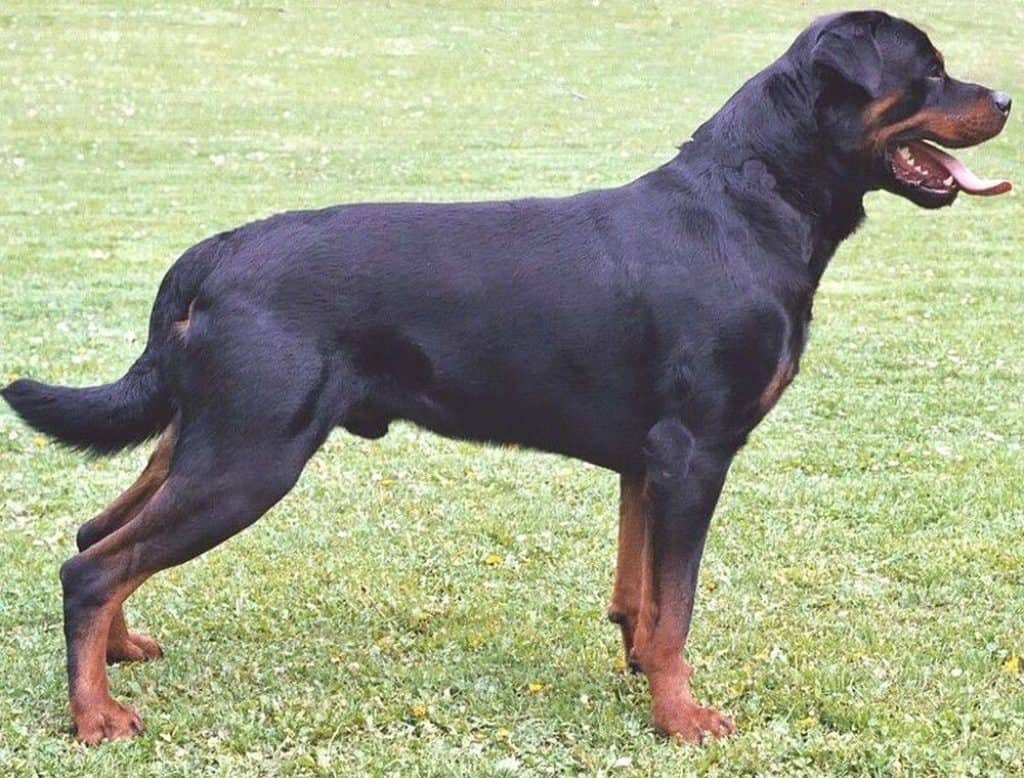
Previously known as Rottweiler Metzgerhund or Rottweiler butchers in Germany. Presently also known as Rott or Rottie.
History And Physical Appearance
The Rottweiler dog breed origins can be traced back to Germany in a town known as Rottweil.
It was believed that the Rottweiler is a descendant of the Molossus and the Italian Mastiff.
However, research conducted shows that the Rotts may have descended from the dogs introduced by the Romans during their reign in Germany which was around 12 BC- AD 16.
They were bred to herd and drove cattle to the market.
During World War 1, Rottweilers actively participated as guard dogs, messengers, and pullers of heavy loads.
This dog breed excelled at police work to the extent that the German Police Dog Association in 1910 recognized it as the 4th official police dog in Germany.
In 1931, the American Kennel Club (AKC) officially recognized the Rottweiler as a working dog.
The AKC, in 2017, ranked this dog breed as the 8th most popular dog breed in the USA.
This workaholic dog breed can grow to heights of 22-27 inches long and around 38-59 kgs as an adult.
Their massive heads, broad and large black nostrils, powerful square muzzles with dark gums and 42 teeth, medium-sized almond-shaped dark brown eyes, and triangular ears that somewhat hang on their heads give these dogs their distinguishing features.
Their short straight and water-resistant double coats come in a variety of appealing shades, with the most commonly occurring coat colors being; Tan, black, mahogany, and rust.
Lifespan And Health Conditions
The Rotts have a lifespan of 8-10 years. Certain medical conditions have been known to lower their life expectancy and quality.
These medical conditions are;
Elbow and hip dysplasia, eye conditions (cataracts, progressive retinal atrophy), hypothyroidism, heart conditions (aortic and subvalvular aortic stenosis) Osteosarcoma (OSA), which is a malignant bone tumor.
Nutritional And Exercising Requirements
Rottweilers should be fed with foods rich in high quality and pure proteins.
So, consider feeding it twice a day with chicken, lamb, and turkey. Carbohydrates and fats should also be supplemented in your Rottweilers meal plan.
Vitamins and essential minerals should also be included in your doggy’s diet.
Ensure that you feed your doggy with cooked food. This will help prevent food-borne illnesses that may sometimes be life-threatening.
Also, don’t forget to provide your Rott with plenty of freshwaters.
Pro-tip; Always adjust your dog’s quantity of food and water in accordance with its age, weight, gender, and level of activity.
Note! Rotts are prone to obesity, so be sure to stimulate them physically on a daily basis.
Consider taking them out for a swimming or a running session. A 30min to 1 hour session is enough to keep your hound physically fit.
Grooming needs
A once in a month bath is enough to keep your doggy smelling fresh and clean throughout.
It’s essential that you brush your Rott at least 4 times a week to de-shed and also reduce excessive shedding.
Always use a firm, rounded-tipped dog brush when combing your dog’s hair.
Consider brushing your Rottweiler’s teeth at least once a week.
Don’t forget to trim its nails with sterile and dog-safe clippers. Use treats to improve your dog’s receptivity to its grooming schedule.
Pup tip; Never bathe your Rottie with a human shampoo or brush its teeth with human toothpaste. Avoid brushing your doggie’s hair when it is wet.
And don’t over bath it as you risk irritating or disturbing its skin pH balance which may consequently cause it to have a skin infection.
Temperament
This good-natured and agile dog breed exhibits high levels of alertness, fearlessness, loyalty, and protective nature.
All these qualities make this intelligent, playful, energetic, and affectionate dog an excellent guard and watch dog.
It’s important to NOTE that Rottweilers are NOT vicious or aggressive as many people would have you believe.
They only become aggressive when inadequately trained or when they experience a traumatizing situation.
So be sure to train your Rott at a young age all the basic obedience commands.
Make sure that you do it in a loving, assertive, and firm manner. Don’t shout or yell at your hound when training it.
I strongly recommend that you hire a professional doggy trainer if you are not sufficiently equipped to train your Rottweiler.
Great Dane Vs Rottweiler – What’s The Difference?
| Great Dane | Rottweiler |
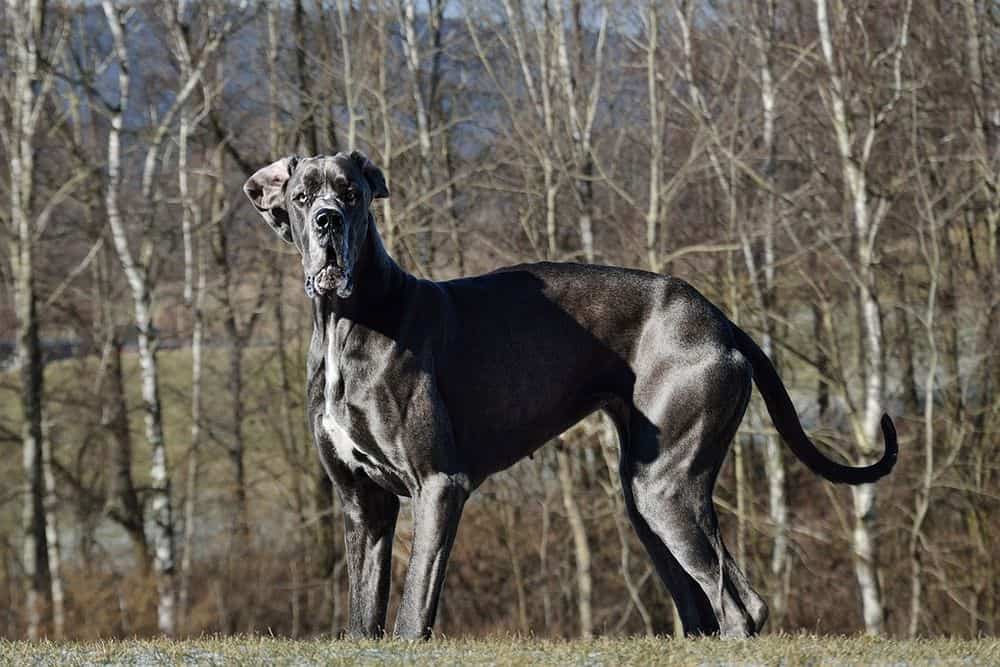 | 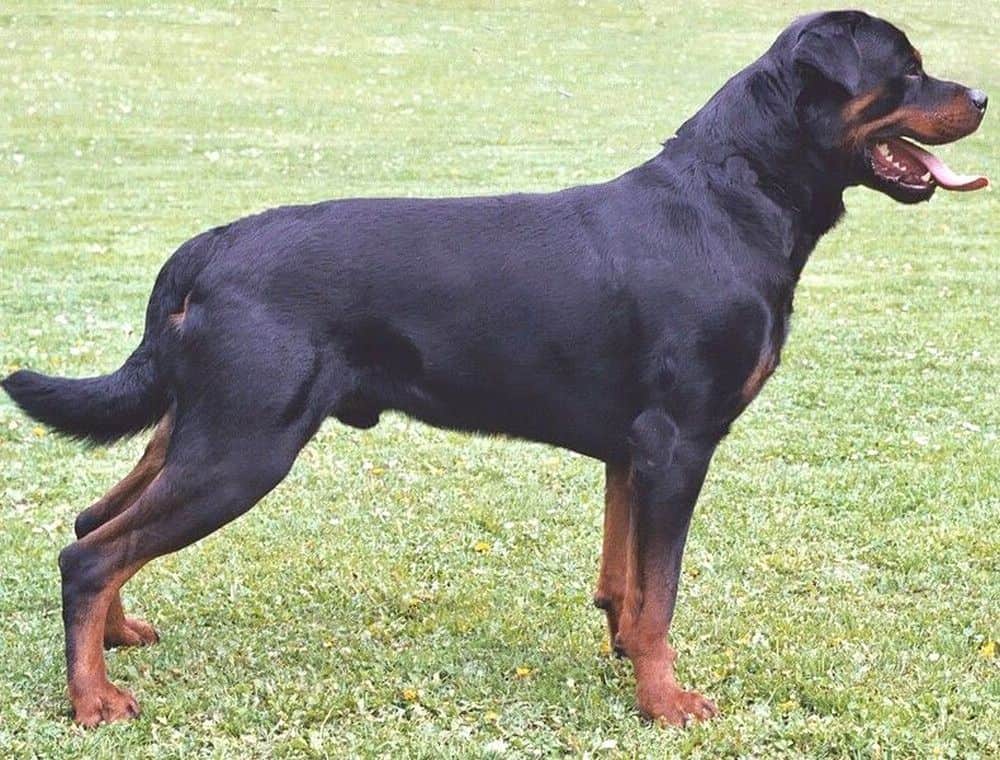 |
Size
Great Danes can grow to heights of 28-32 inches and weight around 45-90kgs. Rottweilers can grow to heights of 22-27 inches and weigh around 38-59 kgs as adults.
This means that Danes are larger in size than Rottweilers.
Lifespan
Rottweilers have a lifespan of 8-10 years, whereas the Great Danes have a life expectancy of 7-10 years.
This means that the Rotts outlive the Danes.
Health Conditions
Danes are healthier than the Rotties as they are predisposed to less heritable and acquired medical conditions.
The Great Danes are way more stranger, kid and pet friendly than the Rottweilers.
Unlike Rottweilers, Danes make an excellent canine companion to senior dog enthusiasts.
Trainability And Intelligence
Rottweilers are more intelligent receptive, and easy to train when compared to the Great Danes.
Independence Nature
Both the Rottie and Dane are not quite independent, as they greatly depend on physical contact with their owners.
However, the Danes are more independent and can tolerate being left on their own, unlike the Rottweilers, who may even develop separation anxiety when left on their own for long periods.
Pro-tip; If you decide to adopt a Rottweiler, ensure that you properly detach it from you at a young age to prevent it from getting separation anxiety or adopting socially unwanted behaviors.
Shedding And Allergy Eliciting Potential
Great Danes shed more than Rottweilers.
This also means that a Great Dane has a higher chance of eliciting an allergic reaction to a dog owner who is sensitive to dog dander than a Rottweiler has.
Barking Tendency
Both dogs don’t bark a lot, but when the 2 are compared Great Danes bark more.
Biting Potential
Despite having a bite force of 400 pounds per square inch (PSI), Great Danes have a very low potential of biting someone or something.
On the other hand, Rottweilers, which have a biting force of 200-400 PSI, have a high potential of biting something or someone when they feel threatened.
Escaping And wandering potential
Great Danes have a more tendency to wander off or escape than the Rotties.
Extra tip; If you decide to adopt a Great Dane, ensure that you never leave it unsupervised on its own when you are in the outdoors.
Consider investing in a heavy-duty, waterproof, and quality leash and use it when going out for a walk with your hound.
Also, have a pro install a high and not see-through fence around your compound.
Litter Size
Great Danes have a litter size of 10-15 puppies, whereas Rotts can produce a litter size of 8-12 pups at once.
NOTE! Excessive breeding predisposes your hound to future health complications which may be life-threatening.
It’s important that you have your dog momma neutered or spayed after successfully whelping (giving birth) 3 times.
Approximate Cost
If you are to purchase a Rottweiler from a reputable breeder it will cost you approximately $1200-$2000.
If you choose to adopt a Dane as your lifetime companion it will cost you around $800-$1200.
This means that Rotts are more expensive than Great Danes.
Great Dane Vs Rottweiler – Which One Is Better?
Great Dane Vs Rottweiler both make excellent family, watch and guard dogs. Both of these dog breeds have their origins traced back to Germany.
They are also very intelligent, affectionate intelligent, and heavy droolers.
These 2 dog breeds are not a good fit for novice owners because they can become strong-willed or aggressive when inadequately trained to follow and obey commands at an early age.
The Rottweilers have a higher biting potential, are more expensive, healthy, and tend to have a longer life expectancy than the Danes.
On the other hand, the Danes have a higher escaping and wandering potential, a bigger litter size, bark more, and shed more when compared to the Rottweilers.
Great Danes are way more stranger, kid and pet friendly than the Rotts.
This makes them an ideal fit for dog owners who have kids, regular visitors, and other pets around.
However, due to their large size, I recommend that you consider adopting another dog breed if you have toddlers in your home.
Always make sure that you adopt a dog from a reputable dog breeder and that complements your personality

